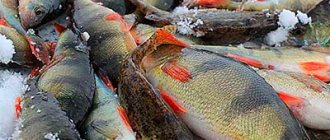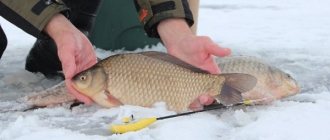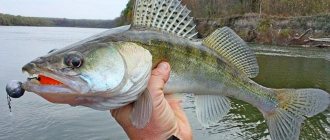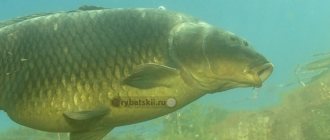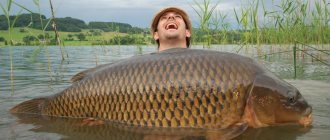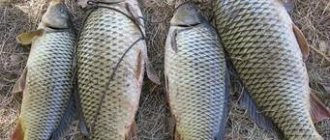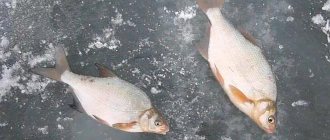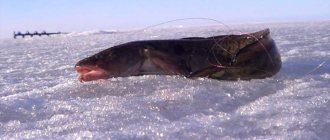Winter carp fishing is gradually becoming increasingly popular. The thing is that it was previously believed that this fish hibernates for the winter, practically does not feed and, accordingly, does not respond to bait. However, this opinion is erroneous, as evidenced by the rich catches of experienced fishermen. If you are also a fan of river fish and winter fishing, you will find this article useful, which describes in detail the features of carp fishing in winter.
We will look at what habits are typical for carp in the cold season and where it is best to look for this fish, and also pay attention to the selection of suitable gear and fishing techniques.
Nuances and difficulties
Successful fishing requires an understanding of how carp behave under the ice - when, where and what they feed on. Like most other fish species, this big guy can be extremely capricious in cold water. The quantity and quality of bites is influenced by both finding promising points and experimenting with baits, groundbait and tackle.
When and where to catch carp in winter
The freeze-up season varies in length in different regions, but everywhere it is conventionally divided into three periods:
- First Ice . The time of greatest activity of carp. There is still a lot of dissolved oxygen in the water, and the temperature has not yet dropped to the winter minimum.
- Deaf winter. The most difficult period for carp fishing is in winter on a pond or small remote lakes. In some wild lakes, the bite stops almost completely; fish hatches are observed only occasionally. Mostly small thaws with stable atmospheric pressure and wind. In “warm” reservoirs fed by heated wastewater from enterprises or power plants, the effect of deep winter is least noticeable, and sometimes is completely absent as such.
- The last ice . Fish activity increases significantly as the ice melts, but the bite is unpredictable. When meltwater enters from the shores, carps rush to shallow waters in search of food and fresh water. The confluences of rivers and streams become promising for fishing.
In general, you should look for carp in winter in the same areas of the reservoir as in summer. He is reluctant to leave his favorite places, and if he does so, it is not for long. Mostly fish found:
- on deep-sea snags with depth differences;
- near steep river banks with deep dumps;
- in pools and edges of holes with inflows of clean water;
- on flooded riverbeds of ponds formed by former rivers;
- in any areas with warm currents caused by hydroelectric coolers or relatively clean industrial wastewater.
Optimal weather for fishing
There is no constant direct dependence of the bite on the weather, but there are a number of proven observations:
- Carp are most active in winter on long cloudy days with an air temperature of -5 + 5 degrees. In the depths of winter, sudden thaws are accompanied by snowfall or rain.
- A steady wind blowing in one direction for several days is also a good sign. At this time, carp can feed for several hours in a row, albeit with varying intensity. “Persuading” him to bite is a matter of technique!
On a note! Sunny, windless days are pleasant for anglers, but they are productive only on the first or last ice, and in strong winds with gusts it is better to abandon fishing altogether.
The importance of bait and how to feed it correctly
The carp is known for its passion for tasty food; for its gluttony, it is jokingly called the piglet.
In winter, the big guy does not forget about his preferences, but feeds periodically and not at all in such quantities. If carp like strong, fruity or spicy aromas in warm water, then it is better not to use them in winter.
Advice. The addition of animal components (bloodworms, maggots, pieces of dung worms) makes the bait much more attractive. The movements of the larvae arouse instinctive interest in carp, and the high content of animal protein makes them a tasty prey in difficult winter conditions.
Regular feeding of worked holes over several days further increases their catchability. An enchanting effect is created. Carp gets used to food at a certain point and eats it more willingly, mistaking it for something completely natural.
We recommend reading: Fishing for carp: how to properly catch carp in a pond and on a river
At depth or current, food is added to the water using a “dump truck” or balls are formed from the mixture, which are simply lowered into the hole.
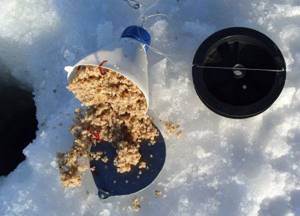
Important. The components of the bait must be selected in such a way that the finished mixture completely crumbles at the bottom. The effectiveness of the feeding point decreases when large glued pieces lie on the “table”.
For feeding, both factory-made carp mixtures for cold water and homemade compositions based on cereals, crackers or mixed feed are used.
Baits and lures
For carp hunting to be productive, you need to prepare and feed the holes. Working food for carp, according to the advice of experienced fishermen, consists of 90% inedible (low-calorie) ingredients, and 10% edible. You should not use flavorings, just add a little bloodworm. Such bait will perfectly attract fish to the hole without saturating it. No more than three hundred grams are thrown into the hole per day.
Read! Catching burbot in winter with a snitch
The feed mixture can be either finely or coarsely fractionated, used raw (compound feed used in fish farms) and boiled. Each fisherman has his own secret recipe for making it.
Catching baits and attachments are: dung worms, bloodworms, insect larvae, boilies, pearl barley and wheat grains.
What do you use to catch carp in winter?
This big guy offers serious resistance when fishing, which, taking into account the size of some individuals, requires preparing tackle with a good margin of safety. If you plan to fish on a small lake, where the main size of the carp does not exceed 1-2 kilograms, you can limit yourself to ordinary gear, for example, bream gear.
Fishing rods
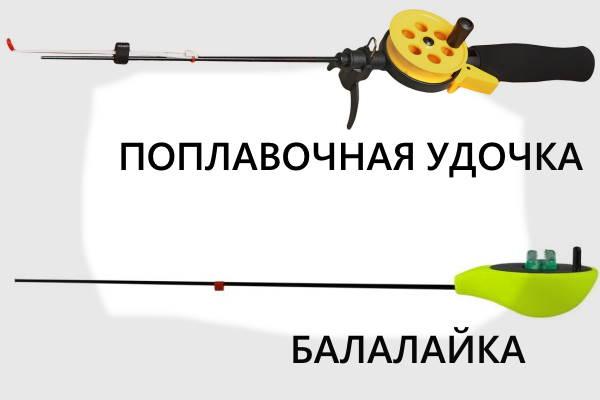
For winter fishing for carp, two main types of winter fishing rods are used:
- Classic fishing rod with handle. Universal tackle, suitable for fishing with a jig with a nozzle or fishing with a hook with a float from the bottom. Equipped with strong fishing line and powerful hooks, such tackle is used on large ponds and reservoirs, where a trophy weighing 3-5 kg or more often lands. The length of the fishing rod with a handle is selected based on the angler’s preferences, varying between 30-100 cm. A long whip allows you to fish with a straight back, without bending over the hole and, if necessary, smoothes out strong jerks of large carp. Due to its length, the fishing rod can be left “charged” on the ice for a short time, without fear that when it bites and hooks itself, the fish will pull it into the water.
- Sports fishing rod "balalaika". Consists of a miniature reel and a small whip. Designed for fishing with a reelless bait and regular jigs with attachments. The balalaika is convenient for shaking out small carp during periods of low fish activity.
fishing line
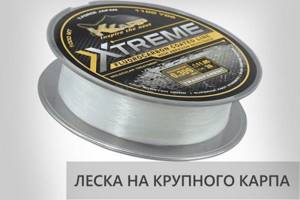
Fishing for carp in winter allows the use of monofilament lines and braided cords. The first is inferior to wicker in terms of tensile strength, but is almost transparent in water and freezes less in cold weather.
When catching small specimens, monofilament with a diameter of 0.12-0.16 mm is most often used. For medium-sized carp, 0.18-0.2 mm is suitable. For targeted trophy fishing, it is better to arm yourself with a strong fishing line with a cross-section of 0.2-0.3 mm.
Float
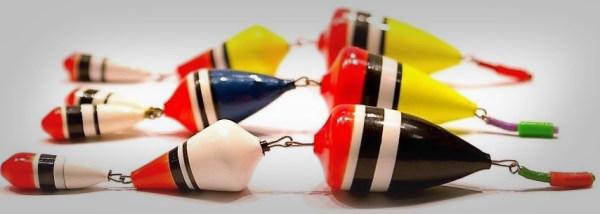
To signal a carp bite, any type of winter floats is used. Considering that you have to fish with larger hooks and sinkers than for other carp fish, accordingly, floats are used with a greater carrying capacity. When fishing at night in a tent, it is convenient to use two-piece or pop-up models. For daytime fishing, simple pieces of hard foam with a longitudinal slot for attaching to a fishing line are suitable. Such homemade products are compact and convenient when moving from hole to hole. The float can be any color, but bright acidic shades are more noticeable against the background of ice and water.
We recommend reading: Catching chub with a spinning rod
The main difference between winter floats and summer ones is that in combat condition they are completely under water and are not covered with ice. They float to the surface when the bait is lifted and sink if the fish is pulled to the side by the hook.
Nod
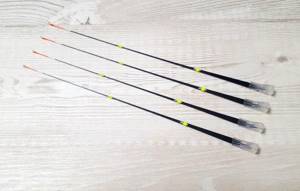
The game of the jig when fishing for carp is very similar to its animation when fishing for bream in winter. Carp does not really like flickering, preferring a smooth, sweeping game. Long (15-20 cm) metal or lavsan nods are best suited for this.
Important. Choosing a jig game is not always easy. It is necessary that the weight of the bait corresponds to the carrying capacity of the nod, otherwise it will be underloaded or overloaded.
Jigs and hooks
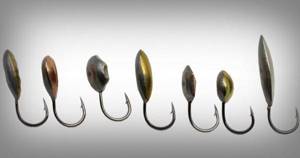
When ice fishing for carp, jigs are most often used. This bait is universal; it allows you to fish on tremors and from the bottom. It is impossible to give strict recommendations on the shape and color of jigs, since on each reservoir the preferences of carp can change, and even several times a day.
As a rule, models of classic rounded or oval shapes (pellet, uralka) work well.
The most commonly used colors are silver or gold. When the bite is weak, plain black or white jigs sometimes help out.
The combination of hook and sinker sometimes helps out in the dead of winter. At this time, the carp is very capricious. Having taken the bait, he feels an unnatural mass for its size, becomes wary and loses interest in it. In such difficult conditions, it is better to tie the hook so that its distance from the sinker is 10-15 cm. Infrequent play near the bottom can interest the fish and provoke a bite.
Lures and Lures
Plant baits are used infrequently, but they work well for active carp. Of these I would like to highlight:
- boilies (floating and sinking);
- pelovka;
- corn;
- peas;
- semolina.
The following are used as live baits:
- bloodworm;
- maggot;
- worm pieces.
Maggots and bloodworms are placed on the hook in several pieces, mixing them for experimentation with each other, with a worm or with plant baits.
On a note! Floating boilies on a hair mount work better than other vegetable baits on sluggish fish due to their weightlessness and hovering in the water.
The use of flavorings increases the chances of catching large fish.
Lures
Artificial
Jigs
For carp fishing, lead and tungsten jigs of medium and large size are used. It is believed that the most catchy jigs are those that have a color that reminds carp of its summer delicacy, i.e. peas, corn and other vegetable baits. Accordingly, jigs should be golden, yellow, dark green, gray, but not bright. The carp tends to ignore the latter.
Spoons
On the first ice, carp can grab small spoons, which are best equipped with a hanging tee.
Balancers
There is an opinion that carp mistakes small balancers for food competitors and attacks them, but this is only possible on the first ice.
Natural
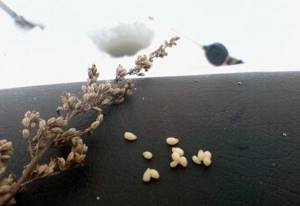
It is believed that in winter carp prefer animal food as it is more nutritious. Therefore, the main baits for carp fishing are:
- bloodworm;
- maggot;
- worm;
- burdock moth larva.
But plant baits can sometimes compete with animal food, and then it is most promising to catch carp on:
- corn;
- peas;
- barley;
- dough;
- boilies.
Boilies for catching carp in winter should be very small.
Fishing technique
Unlike summer, winter carp fishing is less varied and involves only a few basic methods.
On the jig
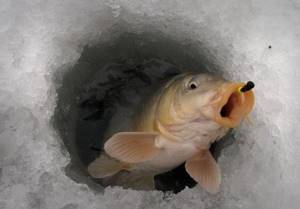
The most common way to fish for shaking is with a slow, smooth action. This animation works well for inactive carp, and in combination with pauses it can provoke it even more.
When catching sluggish fish, slowly raising and lowering the jig near the bottom and above can help out. If the carp does not bite, but has indicated itself with a light touch, you should try to take a short pause or dilute the uniform movement with small fluctuations. To fish with tremors, holes with a diameter of 130-150 are drilled in a checkerboard pattern at a distance of 5-10 meters from each other, then they are fed and fished one by one.
In areas with depths of up to 4-5 meters and clear water, it is better to powder the holes with a small layer of snow with a small hole made in it. This measure is especially important on a clear day, as it prevents light from entering under the ice.
Recommended reading: How to catch a loach
Advice. If after 2-3 retrieves the fish does not indicate itself in any way, it is better to immediately move on to the next hole.
On a float rod
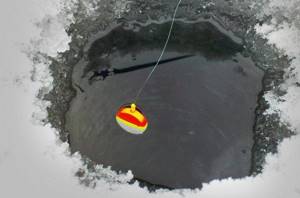
Classic winter fishing that requires perseverance and constant monitoring of the gear. The method is equally suitable for both active and sluggish carp. You can fish with a float at any time of the day. For night fishing, large floats are used, and corn sandwiches with bloodworms, worms or maggots are used as bait.
About bites and hooking
At the end of November or December, depending on the region and weather, carp bites are for the most part confident and reliable. If you delay in hooking, the fish can swallow the bait deeply and it can be difficult to release the hook without a special tool.
With the onset of the January cold and February bad weather, not a trace remains of the mobility and activity of the carp. Bites at this time are more reminiscent of timid touches, and large individuals try the bait more reluctantly and carefully. To get away from zero, anglers have to constantly come up with different tricks - experiment with groundbait, bait, and methods of presenting them. You need to be ready for a bite at any moment and perform a short but sharp hook, which can be oh so difficult to do in a timely manner.
Fishing
Despite the fact that in icy water the carp is not as strong as in summer, sometimes it strongly resists. The outcome of the struggle does not always end in favor of the fisherman and the reason for this is not only a thin line or a poorly tied hook. In open areas where there has not yet been enough snow, the ice is transparent and carp brought close to the hole begin to rush in circles. At such moments, even a fairly strong carp line can rub against the lower edge of the hole, and then a break is guaranteed. To avoid cliffs and, as a consequence, loss of the trophy, you need to try to absorb the sharp pulls of the carp by squeezing the line with your fingers. A long elastic whip and a reel with a friction brake cope best with this task.
Advice from experienced carp anglers
Practical recommendations:
- On an unfamiliar body of water, finding carp can take a lot of time and effort. Drilling 10-20 holes in meter-long ice with a regular ice drill in February or March can be very tedious. Modern assistants - a motor drill or an ice auger equipped with a screwdriver - will help greatly facilitate the search for fish.
- It makes sense to feed working holes also after fishing. This will pull the fish from a larger area and attach it to the desired point. To attach carp, it is advisable to combine plant and live food.
- When fishing for large carp using conventional equipment, you cannot drag it with a drill. The main thing is to take the big guy away from snags or other underwater shelters. After a short struggle in cold water, the fish will calm down, after which it will become much easier to get it into the hole.
- In addition to reliable gear, winter fishing requires the presence of an important attribute - a hook. You can use solid and telescopic models, the main thing is that their length allows you to hook carp even under thick ice.
Fishing for carp in winter does not bring as many bites as catching the same perch, roach or bream, but the size of the prey and the indescribable emotions from fishing it more than compensate for this shortcoming. If you know other ways to catch this large, strong fish in winter, be sure to share them in the comments!
Feeding
You can often hear the opinion that attempts to feed carp in winter lead to nothing. And yet, practice shows that in some reservoirs it is sometimes possible to improve the bite with the help of a depleted (low-calorie) store-bought mixture. It is important not to get carried away, throw bait in modest portions and not too often, otherwise the effect will be the opposite. Fish that eat little in cold weather will quickly become full and ignore the bait.
Alternatively, you can prepare a “lean” mixture yourself. For example, mix crushed worms with breadcrumbs and soil. In this case, the soil should make up at least 40% of the total volume. There is no point in adding large plant components like corn; carp are not interested in them in cold water.
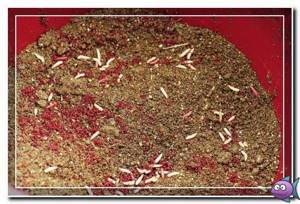
Unfortunately, the use of the mixture often leads to the fact that a variety of fish, mostly small, but not carps, gather under the fed hole. That is why experienced fishermen recommend feeding some of the holes and trying to fish the rest without bait. This strategy allows you to determine whether a bait mixture is needed in this particular place and at this time.

